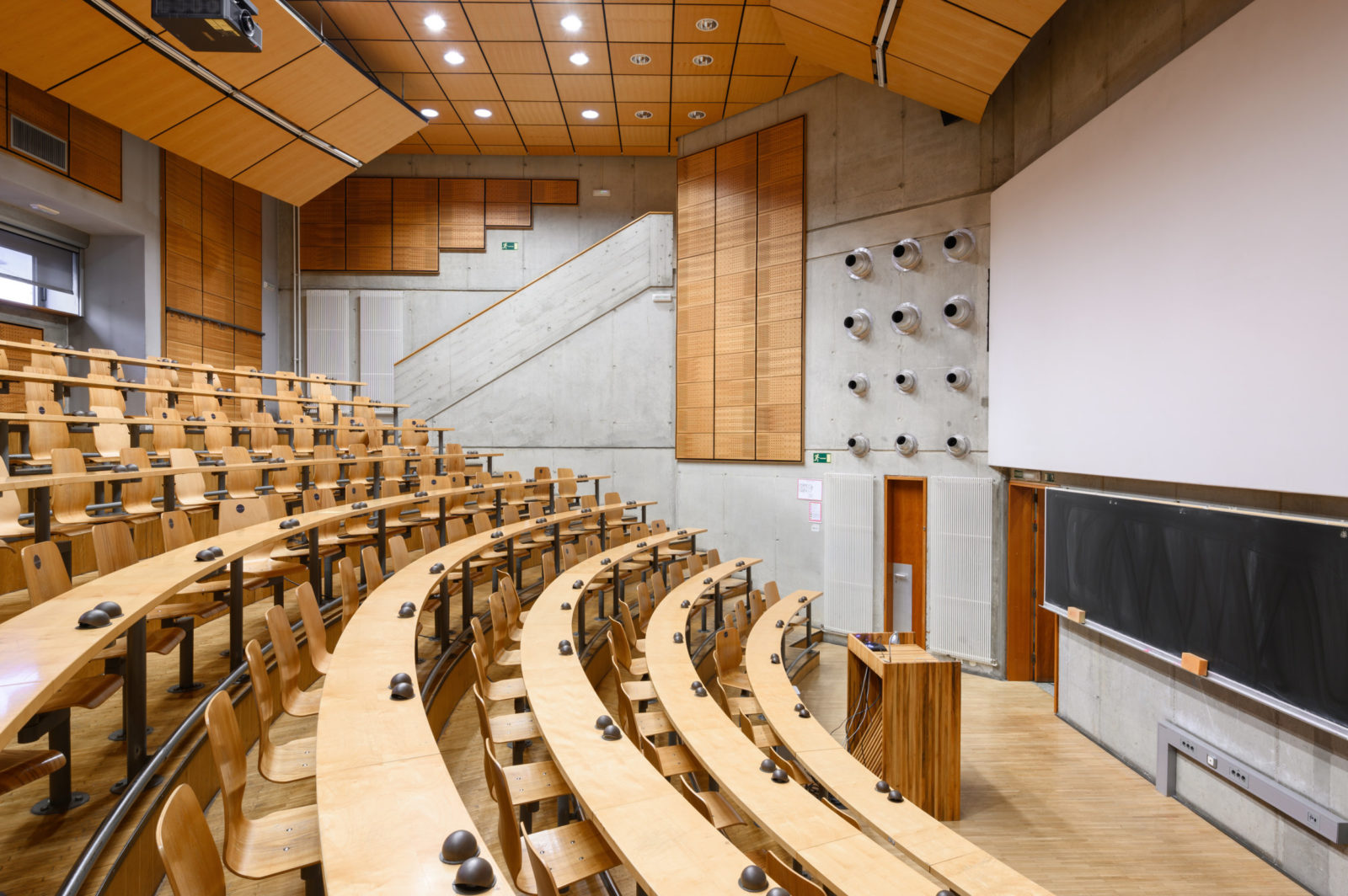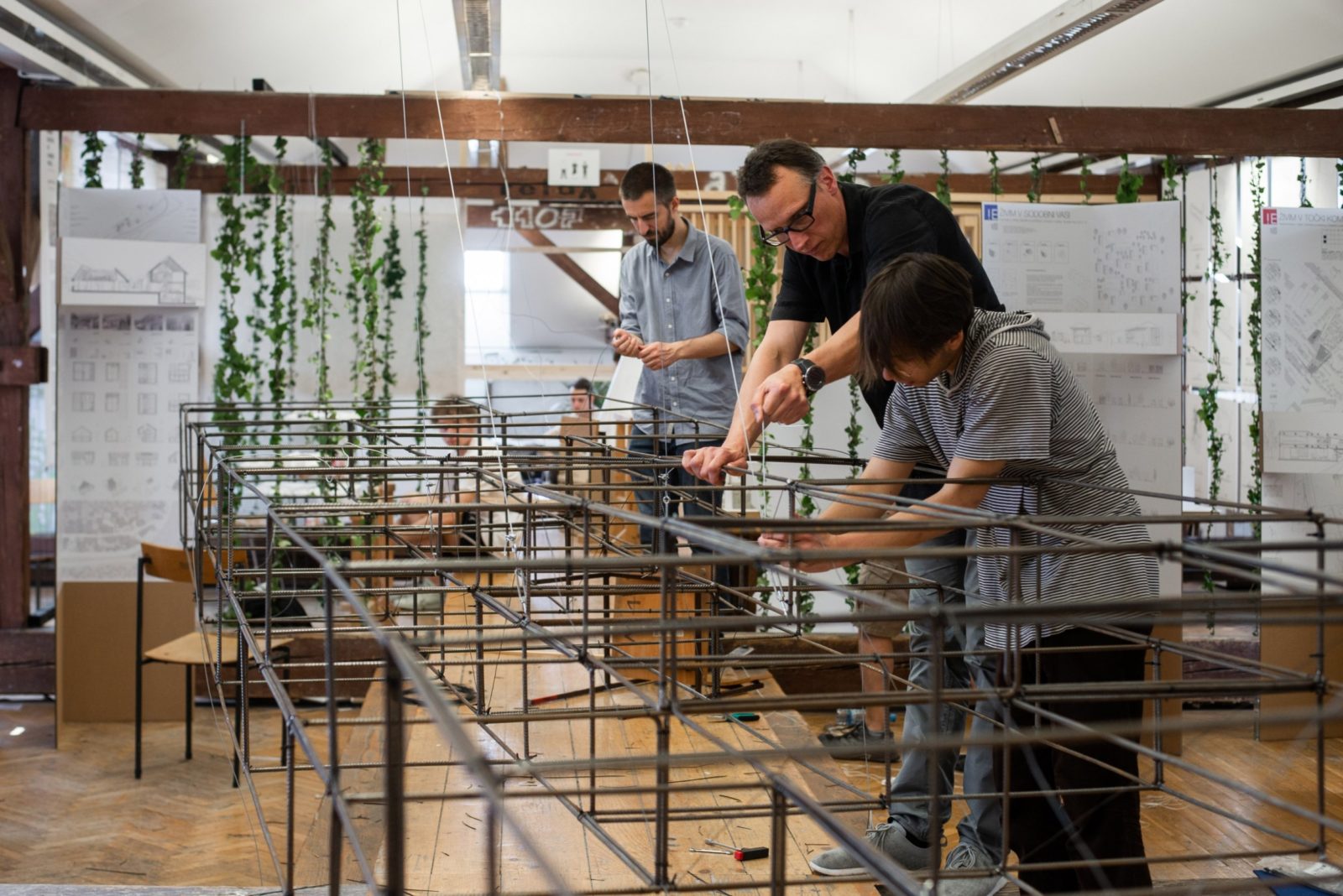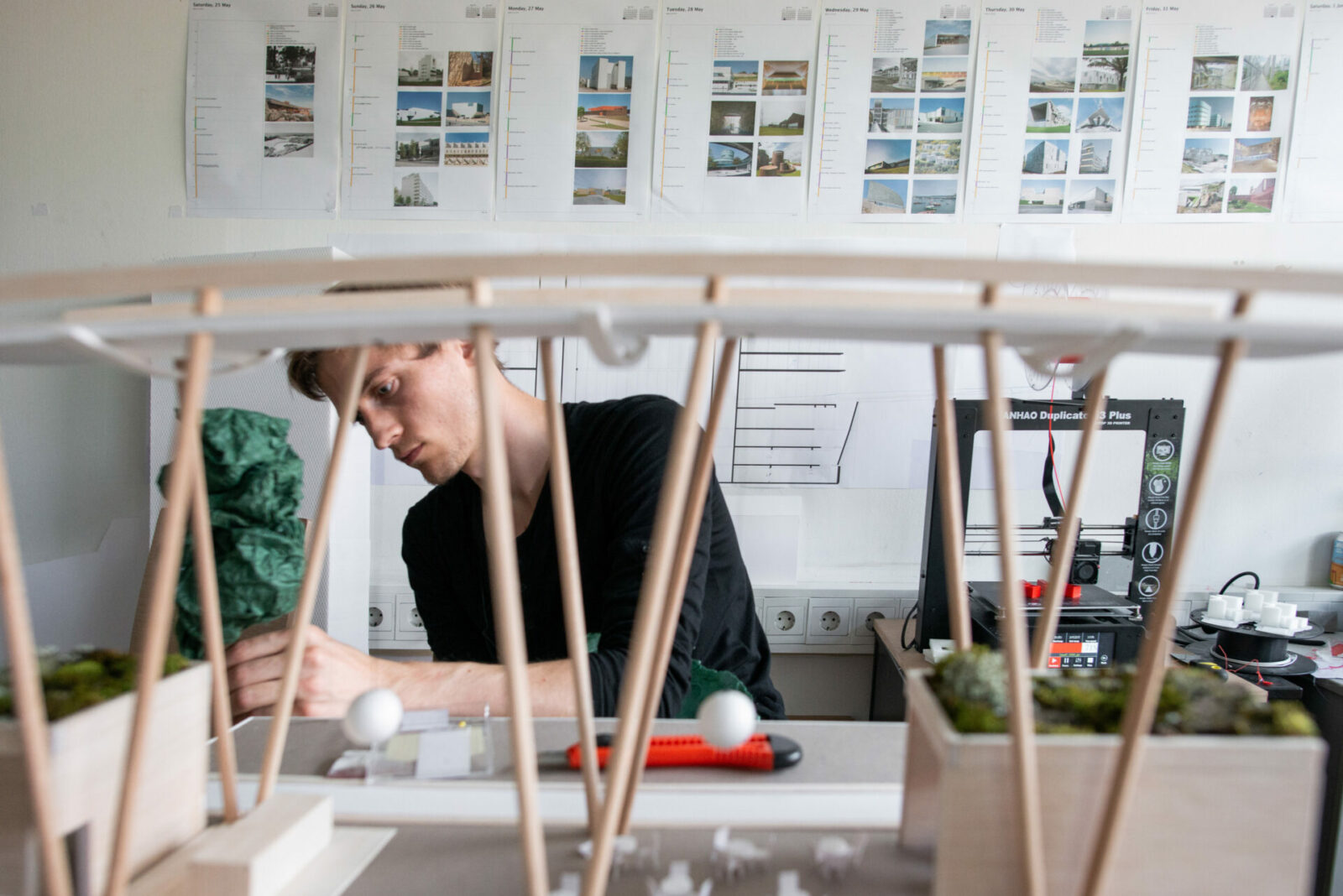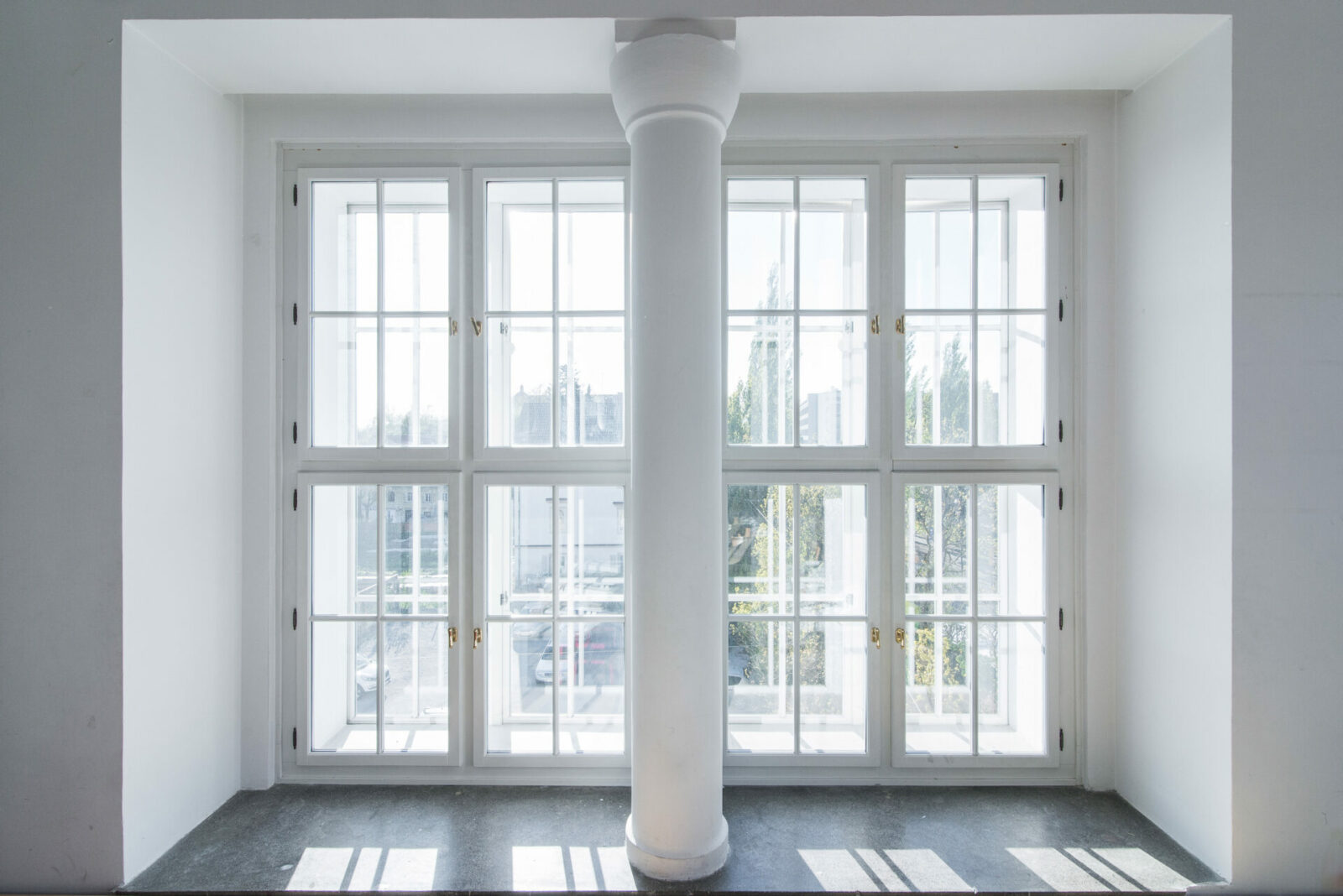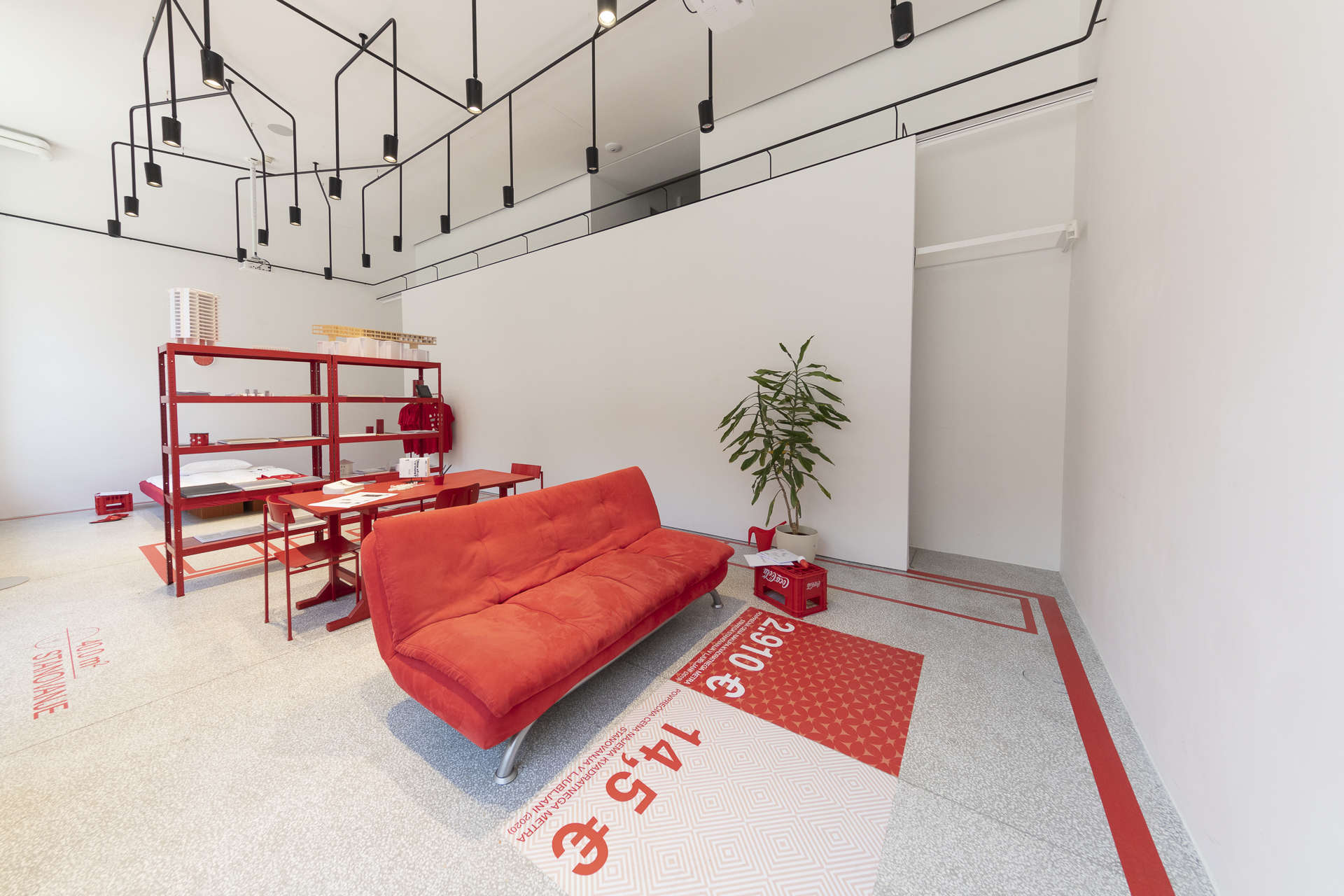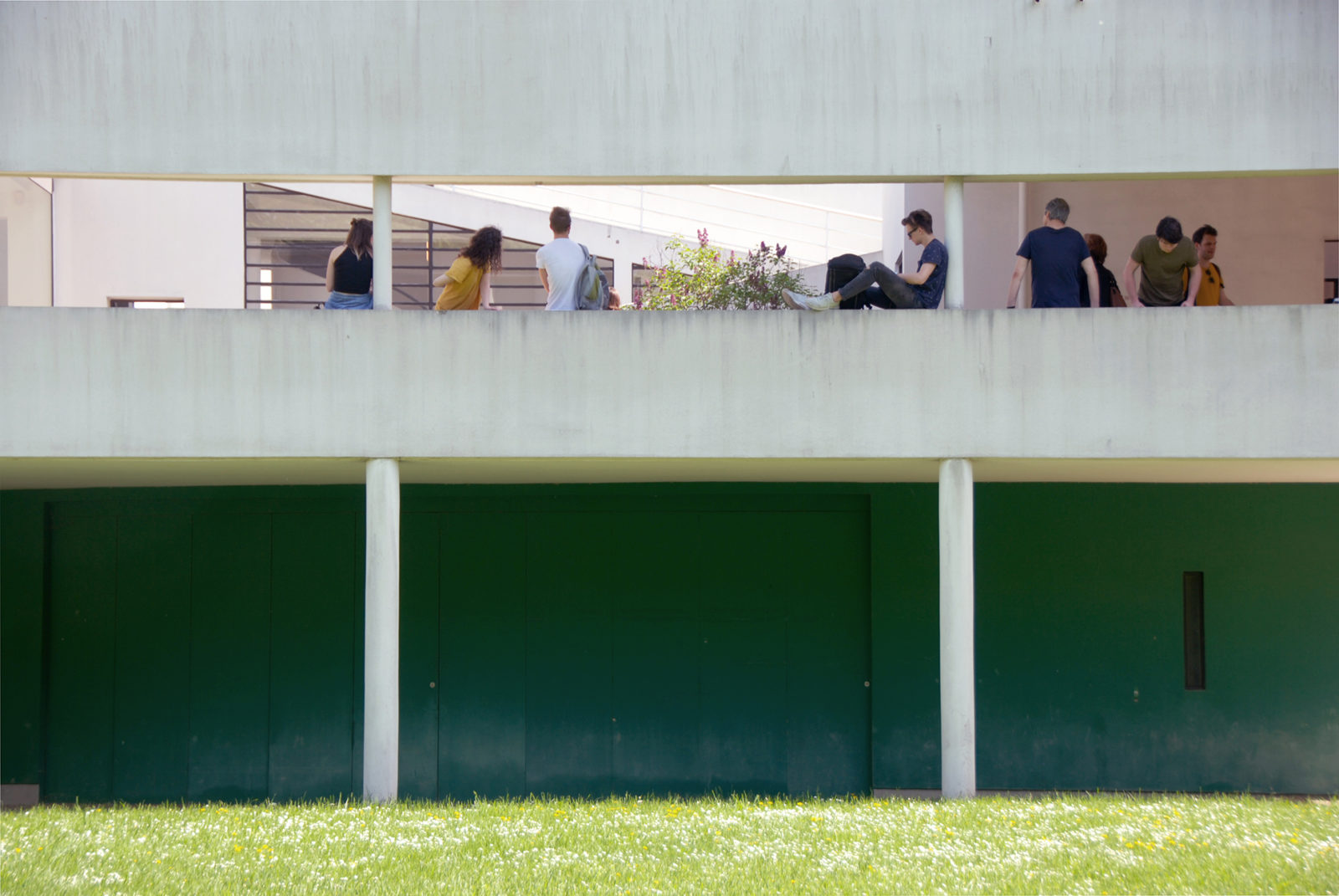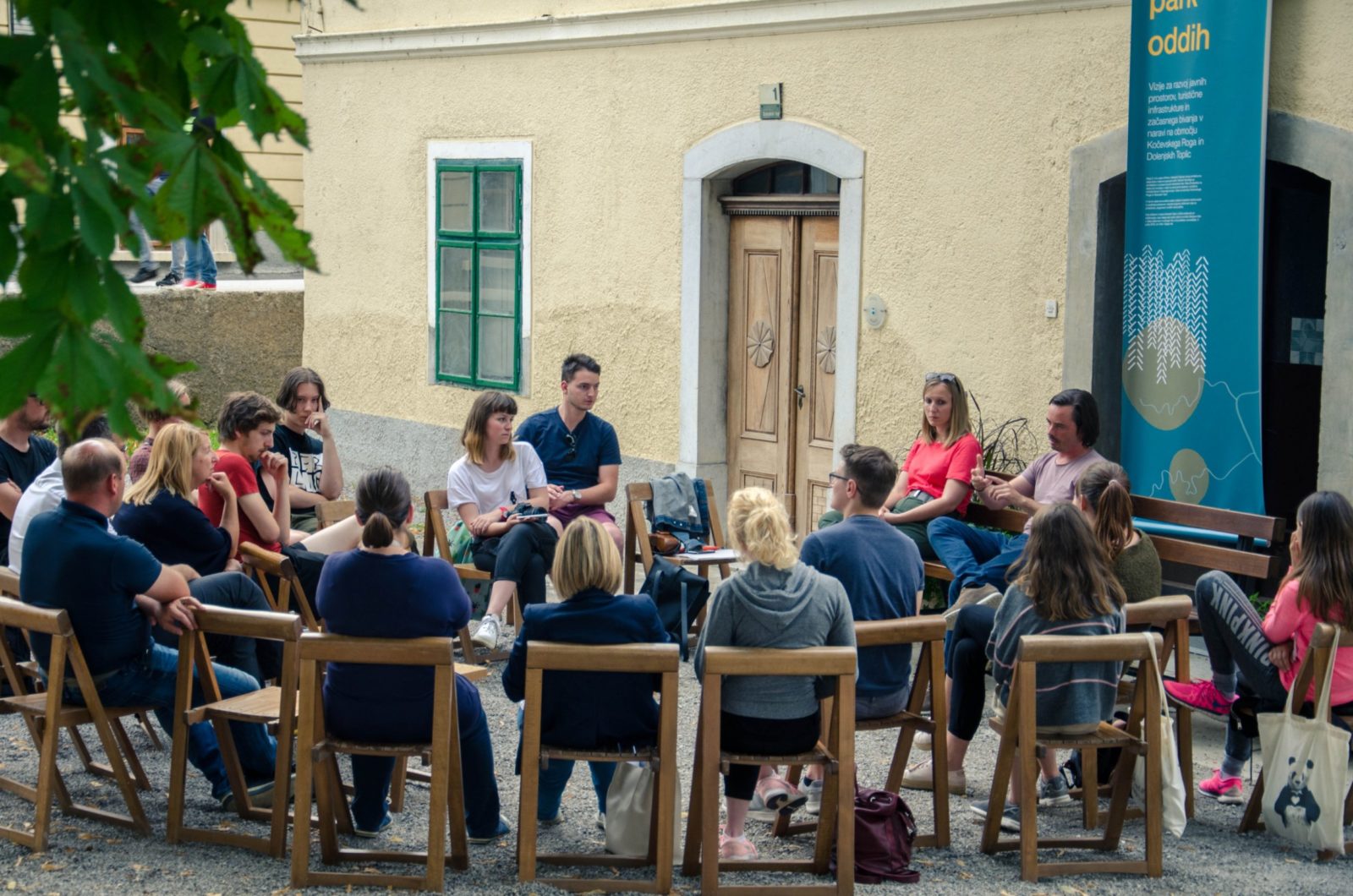About the Faculty
The Faculty of Architecture of the University of Ljubljana is the leading higher education institution in the field of architecture and urban planning in Slovenia. It employs pedagogues and professional colleagues who, with their professional and creative work, earn top national and international achievements in the fields of art and science.
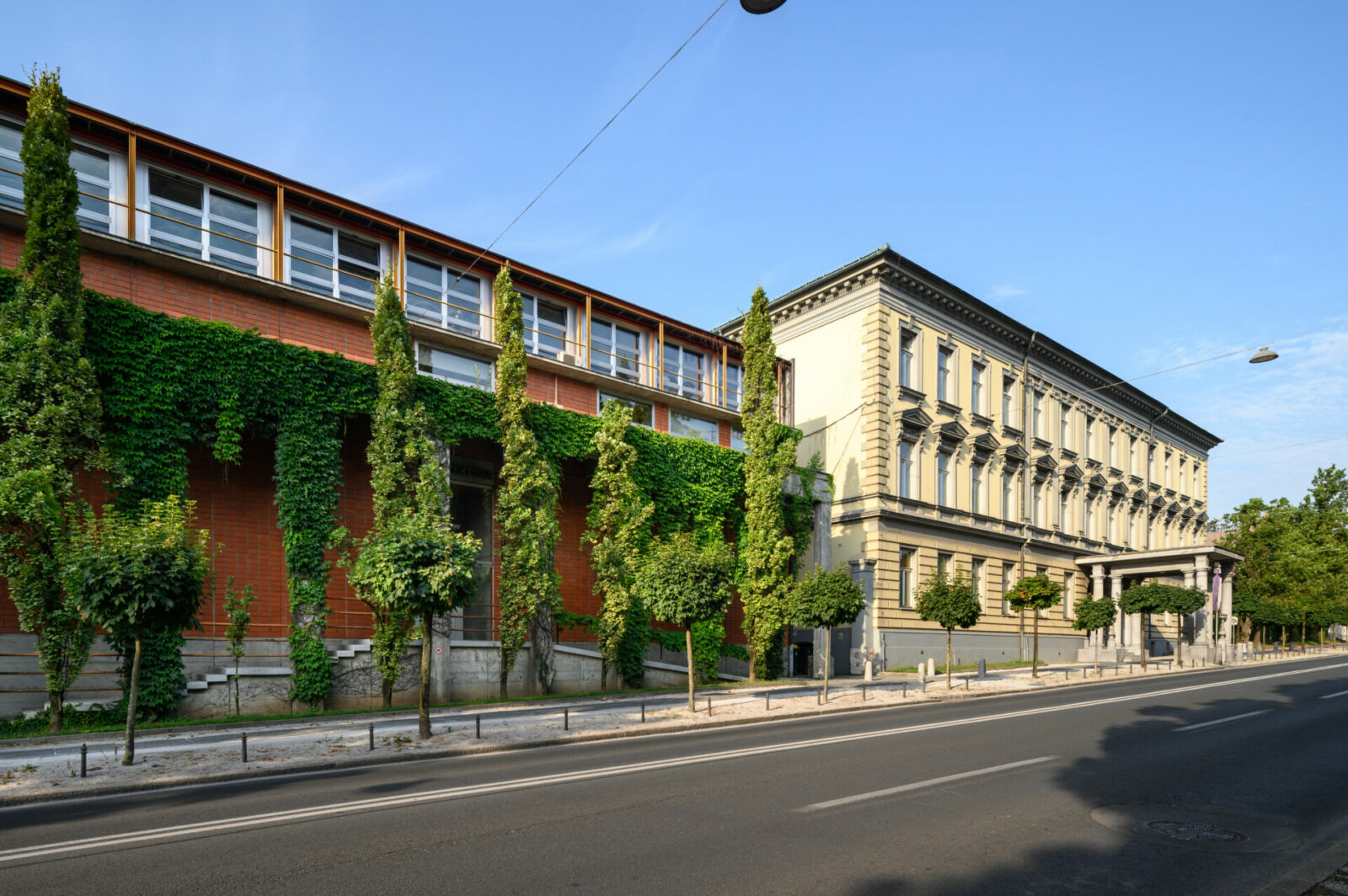
We employ a direct educational approach involving active, practising creators, taking knowledge from business and culture and translating it to the study environment. The faculty strives to provide quality education to future architects and urban planners. On an international level, the institution actively participates in wider regional frameworks. Most of our students come from Slovenia, alongside increasing numbers from Croatia, Bosnia and Herzegovina, Serbia, and North Macedonia.
The faculty’s research work ensures the preservation of architectural traditions, techniques, and helps further the development of modern spatial theories. Our programmes shape critically thinking creators who can work independently in architectural and urbanistic planning, as well as in other creative professions.
Alongside the Museum of Architecture and Design of Slovenia, the Chamber of Architecture and Environmental Planning of Slovenia, and various architectural societies, the faculty helps preserve, promote, and spread the national importance of architecture. It also plays an active role in all major architectural events in the country. With its plurality, scope, and care for quality, the faculty helps lead the discourse on the fundamental values of architecture, space, and spatial culture
In cooperation with the Urban Planning Institute of the Republic of Slovenia, the Institute of Civil Engineering, and other institutes and organisations, the faculty also contributes significantly through its scientific research work to the identification and definition of key spatial challenges for sustainable development, modern urbanisation, spatial policy, safety, and quality of life. Over the decades its research and other activities have proved to be an invaluable resource for the realisation and implementation of goals set by the Architectural Policy of Slovenia.
Dean’s Address
One of the definitions of architecture asserts that it influences everything and vice versa – everything influences architecture. That is why the work of architects involves broad interest and critical engagement with the world.
The work of the “Ljubljana School of Architecture” follows this definition. The Faculty of Architecture of the University of Ljubljana (UL FA) recognizes architecture as both a research (scientific-technical) and artistic discipline. The nature of research work can be theoretical, conceptual, historical, practical, etc. UL FA’s research links the fields of architecture and urbanism, which overlap and complement one another like two limbs of the same organism. Why organism? Because architecture is just another expression and form of life. It functions not only as the embodiment of time and space, but as part of the global ecosystem. This affords it the power to combat the world’s problems, alongside the responsibility to better ecological, social, and phenomenological circumstances.
21st-century education in architecture and urbanism requires a theoretical, methodological, and ethical debate, wherein we can identify three priorities.
These are as follows: 1. a debate on the purpose of architecture, 2. a debate on the reform of architectural education and 3. a debate on ethics. Since responsible architecture goes hand in hand with responsible architects, education must be geared towards the development of professional ethics on an individual level.
1. A debate on the purpose of architecture
While architectural work involves science and engineering, it cannot do without art and beauty, values and beliefs, or friendship and teamwork. It is one of the most complex and challenging, but equally as beautiful and fulfilling of life’s activities, combining a wide range of personalities, skills, knowledge and commitments. A real-life adventure for the client, the architects and their teams alike. Education, in similar vein, is a life project shared between students and educators.
1.1 Architecture is creative thinking
Both in theory and practice, architecture requires that students and educators remain astute, thinking on their feet. UL FA therefore encourages and teaches thinking with – and through – architecture. In professional, scientific and artistic research, it is planning which serves as our main tool when thinking and acting. Tackling questions of design is a key method to deliberate on multifaceted realities. By plucking contemporary issues affecting our society out of their usual context and placing them into the architectural school – to discuss, question and plan accordingly – we aim to establish a dialogue with the world and develop an architectural science for the present and future.
1.2 Relevant contemporary architecture responds to pressing issues of time and space.
Architecture endeavours to actively shape both the present and future by engaging with pressing concerns of social injustice and environmental crises. Late-stage capitalism, however, poses a continuous threat to the artistic, social, technical, and scientific relevance of this field. Increasingly, architecture is turning into a marketable commodity, another form of luxury product, cultural heritage frozen in time, or into a ruthless tool of capital in the service of profit. The deterioration and fossilisation of the discipline, albeit slow and complex, is difficult to avoid and resist. Still, resistance comes inherent to critical architectural practice, both in terms of theory and design. At the school, we promote critical reflection of what architecture is and what its causes, modes and effects are.
1.3 Form is also a function
Where lie the mission and power of architecture? The essence of architecture lies in design. Commitment to contemporary issues appears to demand more, not less, attention to form, materiality, light and composition. Focus on these basic architectural features thus goes beyond short-term benefits and in no way excludes commitment. We see form as generative potential, a designer of communities, a possibility for effectiveness in space. This includes many aspects of design, including details and materials. Architectural design cannot be seen as a conflict, or competition, between form, function and context, but rather as their creative synthesis. And it is architects who are tasked with and responsible for the creation of form. Beauty and elegance are the sine qua non of all architecture that is noticed, recognized, and rewarded. Such architecture figures as more than just a medium or promotional construct – it stands the test of time, breaking into the canon. And that which stands the test of time is necessarily marked by elegance and beauty. Here, without (or with) doubt, we find the works of Wright, Corbuisier, Mies and, in Slovenia, Plečnik, Ravnikar, Jugovec, etc. It holds true for all periods, and modernity, which is subject to new paradigms, poses no exception.
1.4 New paradigms
New paradigms include: disappearing boundaries between the individual and the environment, man and nature, the part and the whole, long foreseen by science and now turned fact in the digital age; a shift in our notion of identity, fuelled further by the awareness of our hybrid and global nature; emphasis on the reciprocity between technology and organic matter and the different species and forms of life on Earth. It has become a common belief that individuals are social fictions, and that we humans are not necessarily above the rest of the fauna and flora, but just another thread in the tapestry of life. Reason and materialism themselves challenge the purported primacy of the physical world, the dominance of traditional social norms and relations, and capitalism as we once knew it. In this way, the idea of progress has come under fire from a new, more fatalistic perspective. Whether the future will be brighter or not seems to be a very open question, at least for most of humanity.
1.5 Learning from history
As architects, we look to the architecture of the past for inspiration. Architectural history to us serves as a precious source to learn from and with which to carry a dialogue. We reflect on types and references, their past and present meanings, as well as their potential applicability when addressing topical issues. Simultaneously, we are committed to a dynamic approach, aware of the fact that architectural history has overlooked and excluded many architectures outside the mainstream, and thus aim to actively expand its boundaries.
1.6 Tradition and progress
Nostalgia may be an alluring emotion, but it is useless in mapping the contemporary world. This rings especially true for architecture and urbanism. While both should be moving forward at the heart of research and the building of a future world, they appear to be standing still. As George Orwell said, it has always been true that [he] who controls the past controls the future, and who controls the present controls the past. It then follows that our task for the future is to remain aware of the present and the past, while consciously projecting this awareness into the future. The profession and its technologies remain in a perpetual state of flux. Architects need to constantly adapt, learning new skills, unlearning some others, before finally “relearning” them using new methodologies adapted to ever-changing contexts. The education process at UL FA will be collaborative, empathetic, flexible, adaptive, intuitive, open-ended, and focused on possibilities rather than just the content of what is taught. Further, it will respect responsible management of our natural, social and digital environment.
2. A debate on the reform of architectural education
Architectural education falls into three main axes: 1. acquisition of knowledge in architecture in the form of a unique, individual consciousness, congruent with collective needs and ambitions; 2. the study (research) of history and theory; and 3. the application and experimentation with construction, building techniques, materials, construction methods, etc.
2.1. What is knowledge, and what knowledge is specific to architecture?
All knowledge must be defensible. When passed onto students, it does not only mean they must understand and accept it. They need to internalise it, find a connection with themselves, and couple it with the knowledge they already possess. Moreover, this idea must not be taught, but learned, as the result of individual reflection and reasoning on part of each and every student, i.e. the learners. As they do so, they will uncover diverging paths and methods to teach and learn. What these have in common is the goal of connecting and strengthening engagement on part of both students and us educators alike. This type of engagement will not come from coercion, but from an internalized desire, conviction, and outlook.
2.2 If the student acquiring knowledge contributes nothing of their own, they will benefit neither from learning nor teaching
Thinking is comparing. We compare the new with what we already know, thus expanding our knowledge. Teaching that relies on rational explanation and critical dialogue must therefore develop a way of learning where students are incentivised to accept, develop, internalise and, above all, articulate and express their knowledge. For this no longer represents just knowledge, but can also be referred to as a belief, a point of view, an intellectual structure, etc. This means that our task is to equip students with an appropriate set of tools for reflection, as opposed to prefabricated theses and viewpoints equipped with instructions. But that is not all. The formation of a critical attitude stems not from simply learning pre-given techniques and methods. Nor does it mean just the search for logical conclusions and their flaws. It also entails the formation of a certain (not entirely tangible) breadth of mind, an openness of spirit, a morality of inquiry that seeks meaning in the pursuit for truth. And this pursuit must be marked by flexibility.
2.3 More on knowledge in architecture
Students have the right to learn about knowledge in architecture. Moreover, they have the right to critically assess, question and even challenge this knowledge. For anyone who teaches architecture, it is crucial that – in order to teach it well – they live subsumed under architecture. These individuals are no longer just teachers to others, but become teachers unto themselves. Ad infinitum. This is where the story of quality architectural education and good architecture teachers actually begins and ends. The essential lies in the very act of being with architecture. We can only teach architecture inasmuch as we learn from it.
Beware, however; in this familiarity with architecture lurks a near overbearing sense of eeriness, das Unheimliche, which Mateja Kurir writes about in her book “Arhitektura moderne in das Unheimliche: Heidegger, Freud in Le Corbusier”. The work links the teaching and learning of architecture, on the side of both educators and students, with aporia, doubt, anxiety, despair, horror, or – at the very least – boredom. We must be continuously be aware and considering of this fact, meaning that we do not settle for what is given – or achieved. This applies to us, educators, as well as our students.
2.4 Relationship between views and tools
Views, at least in the “professional” sense, are like toothbrushes: everyone has one, but no one wants to share it. Tools, on the other hand–such as research methodologies or digital tools–should be a common good shared between all architects and students. A dialectical relationship between the individual and the community is the modus operandi of the field and, by analogy, of its education.
2.5 Risk of losing foundation
The importance of theory at the institution, as well as the level at which it is taught, have been rising. But das Unheimliche does not stop there. It is important to note the modern global trends in the marketisation of education, which expect of the educator’s performance to be attractive, to animate students, and to make topics exciting above all and at all costs. Even among ourselves have we sensed this duty when planning or carrying out the education process. It is all reminiscent of product marketing, where the packaging is more important than the content, and where images of products are more persuasive than the products themselves. If popular architecture becomes pedestalled as a model for the educator or succumbs to the aforementioned expectations, there is a real possibility that the discipline will lose its value foundation and move towards the spectacle incentivised and required by the media space. When the expectations of students are like this, however, it becomes most inconceivable to produce academic work that preserves the value system of architecture.
2.6 What kind of learning/teaching do we strive for?
A developed theoretical and pedagogical practice is a prerequisite and guarantee for high-quality education of an architectural discipline, which expresses awareness of its foundations, limitations, and potentials. Such an education process also recognizes that inquisitiveness, in both educators and students, requires a certain uncompromising attitude.
3. A debate on ethics
Today, architecture serves as not only the embodiment of time and space, but as part of the global ecosystem. This means it must stop being part of the problem and instead become part of the solution. It must develop the power and responsibility to solve the world’s problems, not aggravate the ecological, social and phenomenological situation. Furthermore, creativity must remain an integral part of future attempts to avert our seemingly inevitable self-destruction.
3.1 What can architecture do?
We place the fundamental social and ethical role of the architectural discipline at the centre of our work. Architecture shapes the spaces we live in. The values we embody as a society are thus also reified through architecture. On one hand, architecture can segregate, direct, exclude, divide. On the other, it can bring people together, create literal common ground and structure spaces open to diversity, resilience and evolution. That is our reason to re-establish architecture as an empowered, transformed and transformative discipline, by shifting focus from what architecture is to what architecture can do.
3.2 From words to actions
Research and education unfold against the backdrop of the search for answers on how to enable architects to work during times of uncertainty and upheaval. How can we act in light of extreme changes to our climate? The construction sector alone is responsible for 39% of carbon dioxide emissions. How can architecture help reduce our carbon footprint and integrate new economic models? How will we act in the face of future mass migrations? How can we ensure social justice for all? And finally, how will we use the resources allotted by architecture and urbanism to sustain our common existence as a society and our lives as individuals? How is architecture intertwined with the foundations and processes of the living and the non-living, the human being and the living and non-living environment?
3.3 The answer to injustice is inclusive architecture
We recognize architecture and urbanism as a composition that combines the what and the who, with what is already there. Architecture never begins as a tabula rasa. It operates in a complex, transversal and multi-temporal reality involving a multiplicity of actors. Considering that, we are exploring strategies to include those who have gone overlooked in urban development. This includes raising awareness of gendered, racialised and status-based regimes of spatial design and their capitalist foundations.
3.4 Raising awareness on the impact of project and spatial decisions
Architecture and urbanism are active social-cultural vectors. In order for architects and urbanists to realise in our work the creative capacity within architecture and urbanism, we must continually conceptualize this work through theory. Thereby, we increase our capacity for critical understanding and consequently, transforming our world, which today is saturated with the instrumental logic of the market, addressing people as consumers. Instead, we can build towards a world that constitutes and supports man in his capacity as a thinking, independent being.
3.5 A transdisciplinary approach
In addition to focusing on architecture as an autonomous science, our approach to it is a fundamentally transdisciplinary one. We want to consider the city, architecture, public space, roads, landscapes, and infrastructure as fully embedded in the processes of the living—human, animal, and plant—or, in other words, the all-encompassing environment. Today’s architecture must, as every discipline, first and foremost re-examine the foundations of not only itself, but also of society and life as a whole.
3.6 UL FA strives towards an academic, open-learning environment
No system can properly function without people sharing the same basic values. Common interests alone are not enough. The agents must also be aligned on the level of beliefs and intuition; otherwise, efficient cooperation is impossible, as no social bonds can be established. It is the combination of shared beliefs and strengthened social bonds that could form the agenda for our teaching teams, courses and seminars, but also for our community as a whole, our students included. Of course, responsibility for the academic environment primarily lies with us, the professors.
The Faculty’s Vision
Quality and Topicality of the Study Programme
The faculty ensures academic excellence and a high level of employability of its graduates, while simultaneously establishing mechanisms for constant improvements to its study environment.
Social Criticism and Importance of Architecture and Urban Planning
With its socially active role, the faculty helps in shaping global living culture as an ethical spatial practice and contributes to the meaning and understanding of spatial interventions within a wider social context.
Active Cooperation with the Community
The faculty cooperates with local communities and economic institutions, emphasizing practical, research-based solutions.
International Recognition
The faculty cooperates with numerous international institutions and associations, boosting its recognition through various artistic and research projects.
Modern Spatial and Information Infrastructure
Through improvements to the information environment and gradual spatial reorganization, the faculty enhances conditions of both its studies as well as artistic and scientific-research work.
Students connect with experts by joining excursions and participating at relevant events, both within and outside the scope of the faculty.
